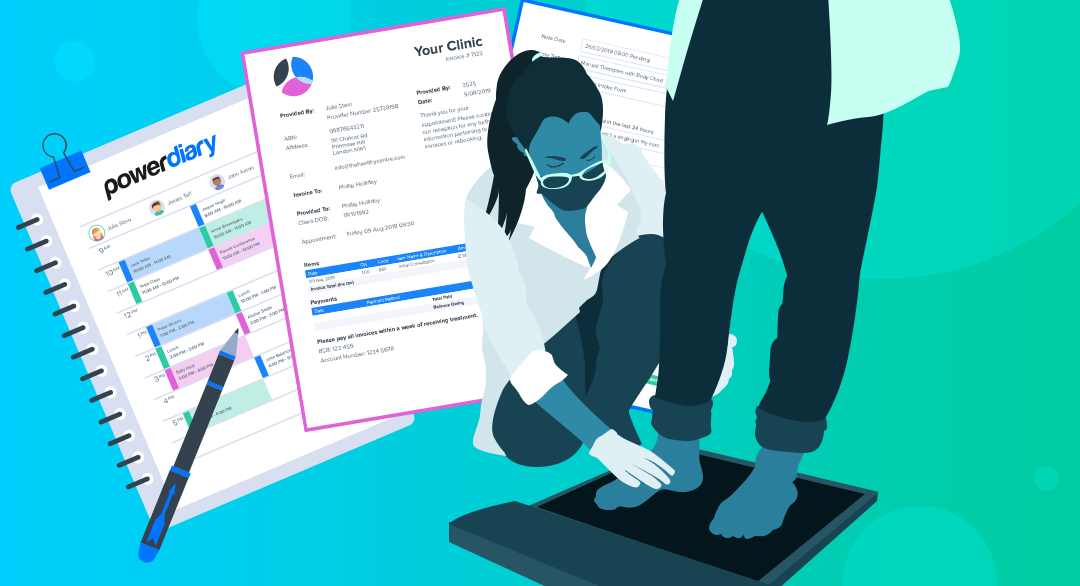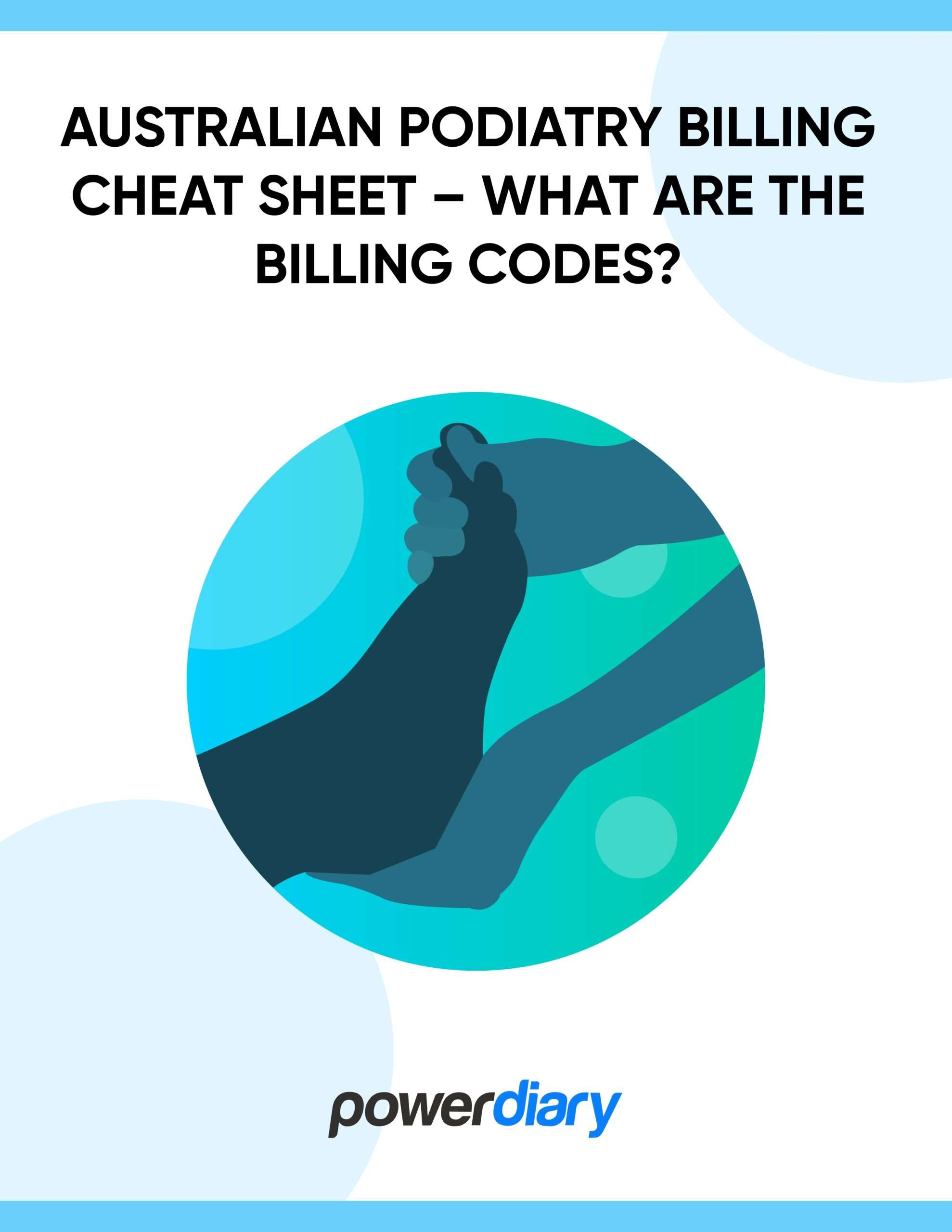Managing a podiatry practice isn’t an easy undertaking. From the day-to-day challenges of keeping your practice running to thinking of new marketing strategies to integrate into your current operations, there’s always too much to do.
But one of the areas that you can’t afford to overlook is billing.
Accurate billing is essential for keeping your practice out of the red and ensuring you fulfil your country’s reporting requirements.
The World Health Organization has described billing errors and healthcare fraud as ‘the last great unreduced healthcare cost’, with over US$400 billion wasted yearly. And in Australia, medical billing education is being investigated as a preventative strategy, aiming to save $A250 million annually from an estimated one to three billion dollars of waste.
Findings in the US and Australia show that healthcare professionals need more legal and administrative training, and most rely on ad hoc, informal, on-the-job education.
The bad news? For podiatrists claiming from insurance, the ongoing challenge is staying up-to-date with best billing practices and the latest billing codes. But the good news is that you’re not in this alone. We’ve drawn up the ultimate podiatry billing cheat sheet for Australian, British, and American podiatrists to help make billing easier for your practice.
Are Billing Codes The Same Worldwide?
Unfortunately, podiatry billing codes are different in each country. However, the World Health Organization (WHO) has developed the International Classification of Health Interventions (ICHI), which is still in beta in an effort to standardise the classification process. It was, to a large extent, derived from the Australian Classification of Health Interventions (ACHI). But, until the ICHI is rolled out and adopted by countries worldwide, different billing codes are used depending on where your podiatry practice is based.
Australian Billing Codes – ICD-10-AM
The ICD-10-AM stands for the International Statistical Classification of Diseases and Related Health Problems, Tenth Revision, Australian Modification, an expanded version of the WHO’s ICD-10. ICD-10-AM/ACHI/ACS is used to classify patients in private and public hospitals and private practice throughout Australia.
In Australia, the ICD-10-AM/ACHI/ACS classification system is split into:
- International Statistical Classification of Diseases and Related Health Problems, Tenth Revision, Australian Modification (ICD-10-AM) – this is used to classify diseases and other health problems.
- Australian Classification of Health Interventions (ACHI) – This is used to classify procedures and interventions.
- Australian Coding Standards (ACS) – This specifies the coding standards that offer guidelines to assist users in specifying clinical coding consistency nationally.
CD-10-AM/ACHI/ACS is used in public and private hospitals in Australia to classify episodes of admitted patient care:
- ICD-10-AM/ACHI/ACS Twelfth Edition is used for separations from 1 July 2022.
- ICD-10-AM/ACHI/ACS Eleventh Edition is used for separations from 1 July 2019 to 30 June 2022.
ICD-10-AM/ACHI/ACS is updated every three years along with the Australian Refined Diagnosis Related Groups (AR-DRG) classification to ensure they are fit-for-purpose and remain clinically current. ICD-10-AM/ACHI/ACS is used for all admitted episodes of care.
In Australia, podiatry services fall under ‘Allied Health Services’ according to the Medicare Benefits Schedule.
American Billing – CPT Codes
CPT (Current Procedural Terminology) codes are standard, universal medical codes that report medical, surgical, and diagnostic procedures and services. The information is used by health insurance companies, health professionals, hospitals, patients, accreditation bodies, and other third parties.
As qualified healthcare professionals, podiatrists need to identify the services they provide and report on those services in a way that can be universally understood. This is essential for healthcare insurers, who process over 5 billion claims annually; data must be captured accurately and consistently to process claims for Medicare, Medicaid, and other health programs.
CPT codes are used with ICD-10 codes to record the services you provide to a patient in their medical records and are then reported to a payer (usually a healthcare insurance company) for reimbursement. The format is a five-digit alphanumeric code consisting of 5 numbers and sometimes four numbers and one letter.
There are approximately 10,000 CPT codes currently in use, and, together with ICD-10 codes, these form the backbone of medical billing. It is, therefore, essential that billers such as podiatrists obtain the new versions of both code sets to stay on top of any changes and avoid the risk of rejected claims.
For podiatrists in the US, the typical medical coding and billing guidelines apply, as well as three other special conditions:
- Claims that involve complicated conditions – these should document the name of the physician who diagnosed the condition and the severity of the diagnosis.
- The nature of the service – non-covered services, regardless of whom they were performed by, won’t be reimbursed.
- Payments that are integral to a covered procedure, even if the incidental service is excluded.
British Billing Codes – OPCS-4
British procedural classifications used by clinical coders within the National Health Service (NHS) are based on the OPCS-4. The OPCS abbreviation is derived from the defunct publication, the “Office of Population Censuses and Surveys”.
Both OPCS-4 and ICD-10 codes are mandated for use across the NHS.
OPCS-4 serves to codify medical operations, procedures and interventions, whether performed during inpatient stays, surgery, as well as some outpatient treatments in NHS hospitals. The structure of the code is different from but comparable to, the AMA’s CPT Code.
Billing Podiatry Services In Australia
Most medical professionals in Australia understand the importance of podiatry interventions for health conditions such as chronic pain, skin and nail care, diabetes, and arthritis.
Because podiatry is such an indispensable treatment, Medicare (Australia’s universal health scheme) offers podiatry rebates. Unfortunately, the Medicare rebate process isn’t always easily accessible.
Clients can access the rebate under the Chronic Disease Management Program (often called the CDM Program, EPC, MBS, or Team Care Arrangement).
To meet the criteria:
- The condition needs to be chronic, something the client has suffered with for longer than three months;
- The client needs to have the appropriate referral form from their GP sent to your specific podiatry clinic;
- The treatment must be delivered by an allied health practitioner.
What Is Covered By National Healthcare In Australia?
Medicare rebates for podiatry services are available under several circumstances. Most commonly, a GP will refer the patient to a podiatrist under Medicare if the patient has a chronic condition with complex care needs managed by the GP, and podiatry consultation or treatment is required.
Under the Medicare CDM Program, a client can have up to five rebated consults with any referred allied health practitioner annually. This includes podiatry, but also physiotherapy, speech therapy, occupational therapy, and more. The number of allowed consults is renewed yearly, but each year will require a new referral. As a podiatrist, you can offer Medicare-rebated services if you’re registered with the Podiatry Board of Australia.
The Medicare rebate covers a specific amount per consultation, regardless of the service that the client receives at your podiatry clinic. Many podiatrists charge an ancillary gap fee.
Medicare typically covers:
- Hammer toes;
- Bunion deformities;
- Heel spurs.
Medicare Part B covers:
- A bi-annual foot exam for clients with diabetes;
- Diabetic peripheral neuropathy;
- Loss of protective sensations.
For clients with private health insurance in Australia, the HICAPS payment system should be used for consultations. The client will need to check with their health insurance fund to ascertain the level of coverage, as this varies significantly between providers and plans.
How Does The Rebate Process Work In Australia If the Patient Is Covered by Medicare?
When a podiatry practice provides a Medicare service to a referred patient, the practice can either Bulk Bill the claim or bill the service as a Private Patient. If the practice Bulk Bills it means that Medicare will directly pay the practice a set amount for each service provided.
In turn, the practice agrees to accept this amount as full payment for the service and cannot charge the patient any additional fees for that service. This means the service is free for the patient, and no money is exchanged between the patient and the practice.
Many podiatry practices don’t offer Bulk Billing as the rate Medicare pays for each service may be considered too low to operate the practice sustainably. In these circumstances, the practice will offer Private Patient billing instead. This allows the practice to set their own fees for each service, which the patient typically pays in full directly to the practice at the time of service. The patient (or the practice on the patient’s behalf) then lodges a claim with Medicare for a rebate. Medicare then pays the rebate to the patient’s bank account.
Power Diary integrates directly with Medicare, enabling podiatry practices to process Bulk Bill or Private Patient claims effortlessly from anywhere, including your tablet or smartphone. Instead of swiping Medicare cards and manually entering referral, service and provider information into a terminal for every claim, with Power Diary, all the required information is already recorded in the patient’s profile. The practice simply clicks a couple of buttons to send the claim to Medicare instantly! If it’s a Bulk Billed claim, the rebate will be sent straight to the podiatrist’s (or practice’s) nominated account, or if it’s a Private Patient claim, the rebate will be sent directly to the patient (or their parent/guardian if the patient is a minor). Medicare claims can be processed individually throughout the day after each service is provided or can be batched and sent together at the end of the day.
Processing Medicare claims via Power Diary is completely free! (And of course, if you have Power Diary, you don’t need a terminal to process Medicare claims, or you can continue to use one along with Power Diary if you prefer.)
What Is Excluded?
In general, if a client doesn’t have a chronic condition or hasn’t been referred by a GP, Medicare will not cover your client’s foot care costs.
Australian Podiatry Billing Cheat Sheet – What Are the Billing Codes?
Podiatrists can claim a maximum of five services per client per calendar year, including services to which items 81300 to 81360 inclusive apply and items 10950 to 10970 for chronic disease management if the client has Medicare. For clients with private health care, HICAPS has a number of predefined podiatry codes.
For Australian veterans, the below schedule of codes is applicable:
In-Clinic Services
F004 Initial Consultation (Initiate new Care Plan)
F010 Short Consultation/treatment (up to 15 minutes)
F012 Subsequent Consultation
F008 Initial Footwear Assessment (Initiate new Care Plan)
F019 Follow-up Footwear Assessment/Fitting
At-Home Services
F024 Initial Consultation (Initiate new Care Plan)
F031 Short Consultation/treatment (up to 15 minutes)
F033 Subsequent Consultation
F025 Initial Footwear Assessment (Initiate new Care Plan)
F026 Follow-up Footwear Assessment/Fitting
Public Hospital Services
F075* Initial Consultation (Initiate new Care Plan)
F046* Short Consultation – 1st Patient
F056* Subsequent Consultation – 2nd and Subsequent Patients
F070* Initial Footwear Assessment (Initiate new Care Plan)
F071* Follow-up Footwear Assessment/Fitting – 1st Patient
F072* Follow-up Footwear Assessment/Fitting – 2nd and Subsequent Patients
*Requires prior financial authorisation from DVA
Private Hospital Services
F065 Initial Consultation (Initiate new Care Plan)
F045 Short Consultation – 1st Patient
F055 Subsequent Consultation – 2nd and Subsequent Patients
F061 Initial Footwear Assessment (Initiate new Care Plan)
F062 Follow-up Footwear Assessment/Fitting – 1st Patient
F063 Follow-up Footwear Assessment/Fitting – 2nd and Subsequent Patients
For Clients with Private Insurance
There are several billing codes available if you’re claiming from private insurance, although they can vary from insurer to insurer. It’s best to get pre-authorisation before providing treatment.
Consultations
F002 Initial Intermediate Service – In Rooms (including history, assessment, diagnosis, treatment, administration and clinical notes)
F004 Initial Comprehensive Service – In Rooms (including history, assessment, diagnosis, treatment, administration and clinical notes)
F005 Initial Comprehensive Service (Diabetes) – In Rooms (including history, assessment, diagnosis, treatment, administration and clinical notes)
F010 Short Consultation/Treatment – In Rooms – Up to 15min (includes: assessment, treatment, administration and clinical notes)
F012 Subsequent Intermediate Service – In Rooms (including assessment, treatment, administration and clinical notes)
F014 Subsequent Comprehensive Service – In Rooms (including assessment, treatment, administration and clinical notes)
F015 Acute Service (Diabetes) – In Rooms
F016 Management Service (Diabetes) – In Rooms
F023 Initial Intermediate Service – Home Based
F024 Initial Comprehensive Service – Home Based
F025 Initial Comprehensive Service (Diabetes) – Home Based
F031 Subsequent Brief Service – Home Based
F033 Subsequent Intermediate Service – Home Based
F034 Subsequent Comprehensive Service – Home Based
F035 Subsequent Acute Service – Home Based
F036 Subsequent Management Service – Home Based
F042 Initial Intermediate Service – Extended Care
F043 Initial Comprehensive Service – Extended Care
F086 Subsequent Intermediate Service – Extended Care
F087 Subsequent Comprehensive Service – Extended Care
Diagnostic Services
F101 Photoplethysmography regional – Arterial
F104 Peripheral Flow Study (Doppler) – Arterial and Venous
F111 Muscle Testing (Manual)
F114 Range of Motion
F115 Computerised Gait Analysis with Detailed Report
F116 Treadmill and Video Gait Analysis
F117 Gait Analysis (Visual)
F118 Biomechanical assessment (includes F111, F114 and either F115, F116 or F117)
F119 Surgical Assessment
Orthomechanical Services and Procedures
F201 Ankle-Foot Orthoses – Custom Made (including supply, fitting and complete initial components including plain covers and posts)
F211 Orthodigital Traction Device (Single) – Customised
F221 Custom Made Functional Orthosis (single) (including supply, fitting and complete initial components including plain covers and posts)
F261 Cushioning Orthosis – Simple (single) (including supply, fitting and complete initial components including plain covers and posts)
F263 Pressure Relief Orthosis – Complex (single) (including supply, fitting and complete initial components including plain covers and posts)
F265 Moulded Cast Orthosis (single) – Customised (including supply, fitting and complete initial components including plain covers and posts)
F267 Moulded Non-Cast Orthosis (single) (including supply, fitting and complete initial components including plain covers and posts)
F269 Heel Lift (single) – Customised
F271 Interior Shoe Padding (single) – Customised
F301 Negative Model of the Foot (single)
F302 Positive Model Fabrication of the Foot (single)
F303 Negative Impression of the Foot and up to the Lower 1/3 of the Lower Leg (single)
F341 Bunion Shield (single) – Customised
F342 Interdigital Wedge (single) – Customised
F344 Nail Brace – Customised
F381 Orthosis Cover – Plain (single)
F383 Orthosis Cover with Soft Tissue Supplement (single)
F385 Orthosis Post – Rearfoot or Forefoot (single)
F546 Nail Root and Matrix Resection with Matrix Sterilisation (single edge)
F547 Nail Root and Matrix Resection with Matrix Sterilisation (total nail)
F548 Nail edge Avulsion and Matrix Sterilisation – Each additional edge.
F986 Consumables Clinically Required Immediately during the Consultation/Treatment
F987 Consumables Clinically Required for Treatment After Consultation
Billing Podiatry Services In the United States
In the US, the Centers for Medicare and Medicaid Services (CMS) define the regulations regarding which services are covered under health insurance. The Centers don’t directly inform insurance agencies, but they influence billing and coding guidelines.
What Is Covered In the US?
According to the CMS, only services considered medically necessary and reasonable foot care are covered. Strict billing and coding regulations stipulate how often a patient can be treated, the treatment setting, and which diagnoses are covered.
Medicare covers:
- Footcare for patients with chronic diseases;
- Wound care treatment;
- Hyperbaric oxygen therapy for hypoxic and diabetic wounds that affect the lower extremities.
The podiatry service must be considered Additional, Mandatory, Supplemental, or Optional Supplemental benefits for routine care. Other services that treat conditions not specific to the foot area (and are therefore not a specialised podiatric service), such as warts, are covered as they would be if they were located elsewhere on the body.
What Is Excluded?
Several podiatric services aren’t covered by Medicare (and may not be covered under general third-party insurance). In general, any elective or podiatric services that are not medically necessary will not fall under ‘reasonable footcare’ and thus won’t be covered by insurance.
As a US-based podiatrist, if you’re billing for foot care services that fall into the below categories, you’re unlikely to be able to claim from insurance:
- Routine foot care, exceptions include initial care that may result in a diagnosis that is covered by insurance, mycotic nails, the presence of metabolic, neurologic or peripheral vascular diseases, or if the patient has diabetes, chronic thrombophlebitis, or peripheral neuropathies;
- Subluxation of the foot, although there are exceptions where the dislocation was of the ankle joint, or forms part of the care that resulted from the subluxation;
- Flat foot;
- Supportive devices, exceptions include therapeutic shoes for patients with diabetes and orthotic shoes that form part of a leg brace.
How Do You Bill For Podiatry In the US?
When you submit a claim you need to include:
- diagnosis
- severity
- podiatrist name
- appointment date
To avoid claim denials, you need to use codes correctly, follow the coding procedure and avoid over-coding. Also, rather than simply stating the condition, you should keep documented proof that the client would experience negative health effects without your intervention.
Can Podiatrists Bill 99204?
Based on the 2021 E/M guidelines, podiatrists now have the ability to bill E/M 99204/99214 as well as E/M 99205/99215. To bill under these codes a medically appropriate history and/or an examination is needed and there’s also a medical decision making or time element. In terms of medical decision-making, it’s best to refer to The Level of Medical Decision Making table. For an in-depth understanding of how to approach Level 4 and Level 5 coding, this article can help.
The most significant update in 2023 is the office or another outpatient, hospital inpatient, observation care, consultation, emergency department, nursing facility, and home or residence E&M services were deleted (CPT 99224–99226).
Can Some Codes Be Billed Together?
Yes. In podiatry, some codes can be billed together for one patient, while others cannot. Examples include:
- 11721 and 11056 can be billed together based on the CPT definitions.
- CPT 11719/20 and G0127 cannot be billed together as both include “any number” of trimmed nails.
US Podiatry Billing Cheat Sheet – What Are the Billing Codes?
In-Clinic Services
99203 – 99204 Office Visit New Patient Level 3 – Level 4
99213 – 99214 Office Visit Established Level 3 – Level 4
29405 Apply Short Leg Cast (Non-weight Bearing)
Q4038 Short Leg Cast Material
20550 Injection Tendon Sheath/Ligament
J3301 Triamcinolone Acetonide (Typically 1 unit used)
*See above for E/M 99204/99214 and E/M 99205/99215 billing changes in 2021
Nail Care and Nail Procedures
11720 Toenail Trim (1 Foot)
11721 Toenail Trim (2 Feet)
11730 Toenail Removal
11750 Toenail Removal (Permanent)
97597 Debridement of Open Wound
17110 Wart or Lesion Removal Up to 14 (Benign)
Orthotics
L3020 Custom Orthotic Materials (OR002)
29799 Casting Impression Fitting (S0395)
97760 Orthotic Management and Training 15 Minutes EachDurable Medical Equipment
L4360 Ottobock Pneumatic Walker (Immobilizing Boot (SS406)
L4396 Foot Night Splint – Treatment for Plantar Fasciitis (SS397)
L1902 Ankle Brace (SS243)
Billing Podiatry Services In the United Kingdom
For podiatrists in the UK, you may be wondering if the NHS covers your services. The answer isn’t completely straightforward because, in short, they could be. To be eligible for referrals to your practice from GPs in the area, you will need to be registered with the Health Care Professions Council (HCPC).
Then, the next step is determining the policies of your local CCG. In April 2013, clinical commissioning groups (CCGs) were given the authority to decide which foot care services would be covered for their area.
NICE (the National Institute for Health and Care Excellence) recommends podiatry services associated with the management and treatment of long-term conditions should be available on the NHS. This includes conditions such as diabetes, arthritis, and peripheral arterial disease. However, they don’t make any recommendations for foot health interventions that aren’t associated with chronic long-term conditions. The result of this is that each CCG needs to decide which services are available on the NHS in their area.
What Is Covered In the UK?
Podiatry services are available on the NHS free of charge, but each case is assessed individually, so whether your client will receive free treatment will depend on the severity of their condition and the associated risk factors. If your client has a high-priority condition such as diabetes, they’ll be able to access free treatment.
Clients will need to be referred to your practice by a GP or clinic, and you’ll need to provide treatment as stipulated by the local Clinical Commissioning Group.
In general, for a client to be eligible for a podiatry assessment at your practice, they’ll have one of the following conditions:
- An ingrown toenail that has not resolved with regular cutting and needs nail surgery;
- An inflamed or infected area of the foot;
- An open or weeping sore on the foot;
- Diabetes;
- Rheumatoid arthritis;
- Lupus;
- Peripheral vascular disease;
- Severe foot deformity.
What Is Excluded?
If their condition does not impact the health or mobility of your client in any way, it is unlikely that they’ll qualify for NHS podiatry treatment.
What’s The Difference Between a Podiatrist and a Chiropodist?
In the UK, the terms podiatrist and chiropodist are used interchangeably, and there’s no difference between the two.
What Codes Are No Longer Available?
While the codes used in private health care can vary, in general, these historical codes are no longer available:
S0633 – skin or subcutaneous tissue (up to 3)
S0643 – excision of lesion of skin or subcutaneous tissue (4 or more, trunk and limbs)
S1110 – Cryotherapy of lesions of skin, including cauterisation (up to 3)
S0820 – Cryotherapy of lesions of skin, including cauterisation (4 or more)
S7010 – Wedge excision or avulsion of nail (including ablation of nail bed)
Orthotics and appliances (such as insoles, shin splints, knee braces and walking aids)
UK Podiatry Billing Cheat Sheet – What Are the Billing Codes?
The NHS doesn’t have charging codes, and the allocation of charges varies depending on whether the podiatry services take place in a primary or secondary care setting, as each has a different classification and coding structure.
In primary care, the Read or SNOMED-CT codes are used for both interventions and disorders (although this doesn’t relate to charging). In secondary care, OPCS-4 (procedure codes) and ICD-1- (diagnosis codes) are used, which are then mapped to Healthcare Resource Groups (HRGs) for costing and reimbursement.
Procedures can be checked on the SNOMED-CT term browser then, using the Classification Map, you can see which OPCS-4 code is used for the procedure. Once you have that code, you can use the Code to Group workbook to see the HRG that the procedure code is mapped to with the user manual, and the current national tariffs are available here.
Private health care in the UK is different. Here, the procedural and diagnostic codes are available on the CCSD website, and each procedure needs to be looked up individually. For example, consultation codes are available here.
Private Podiatrists
AA145 Initial podiatric visit (including cryotherapy and local anaesthetic)
AA641 Follow up Podiatric visit (including cryotherapy and local anaesthetic if no nail surgery has been undertaken
AA628 Avulsion or wedge excision of nail package including local anaesthetic (AC100) and all other charges (includes up to 3 follow-up visits)
AA629 Excision of nail and nail bed, including local anaesthetic (AC100) (includes up to 3 follow-up visits)
AA365 Gait analysis, this includes Biomechanical assessment with video infra-red computerised analysis +/- 3D gait
T5780/T7250 Ultrasound shock therapy for plantar fasciitis or tendonitis
Private Registered Podiatrists and Podiatric Surgeons
AA628 Avulsion or wedge excision of nail package including local anaesthetic (AC100) and all other charges (includes up to 3 follow-up visits)
AA629 Excision of nail and nail bed, including local anaesthetic (AC100) (includes up to 3 follow-up visits)
AA365 Gait analysis, this includes Biomechanical assessment with video infra-red computerised analysis +/- 3D gait
T5780/T7250 Ultrasound shock therapy for plantar fasciitis or tendonitis
Private Podiatric Surgeons
20300 Initial consultation
20310 Follow-up consultation
AA145 Initial podiatric visit (including cryotherapy and local anaesthetic)
AA641 Follow up Podiatric visit (including cryotherapy and local anaesthetic if no nail surgery has been undertaken
AA628 Avulsion or wedge excision of nail package including local anaesthetic (AC100) and all other charges (includes up to 3 follow-up visits)
AA629 Excision of nail and nail bed, including local anaesthetic (AC100) (includes up to 3 follow-up visits)
AA365 Gait analysis, this includes Biomechanical assessment with video infra-red computerised analysis +/- 3D gait
T5780/T7250 Ultrasound shock therapy for plantar fasciitis or tendonitis
S6400 Excision of nail bed (in a hospital setting only). It’s advisable to apply to the health insurance provider for pre-authorisation before providing the treatment to avoid having the claim denied.
Podiatry billing codes vary widely from country to country, and even within the country, there are different billing codes depending on the type of health care plan the client has.
But, if you look closely, it’s possible to identify the common thread that runs through the coverage: if it’s a chronic condition, it will most likely be covered, especially if it relates to diabetes, arthritis, or peripheral vascular disease. Otherwise, general foot care will not be covered unless the client has a comprehensive private health care plan.
*This article, originally published in 2020, has been updated in 2023 for comprehensiveness and accuracy.








